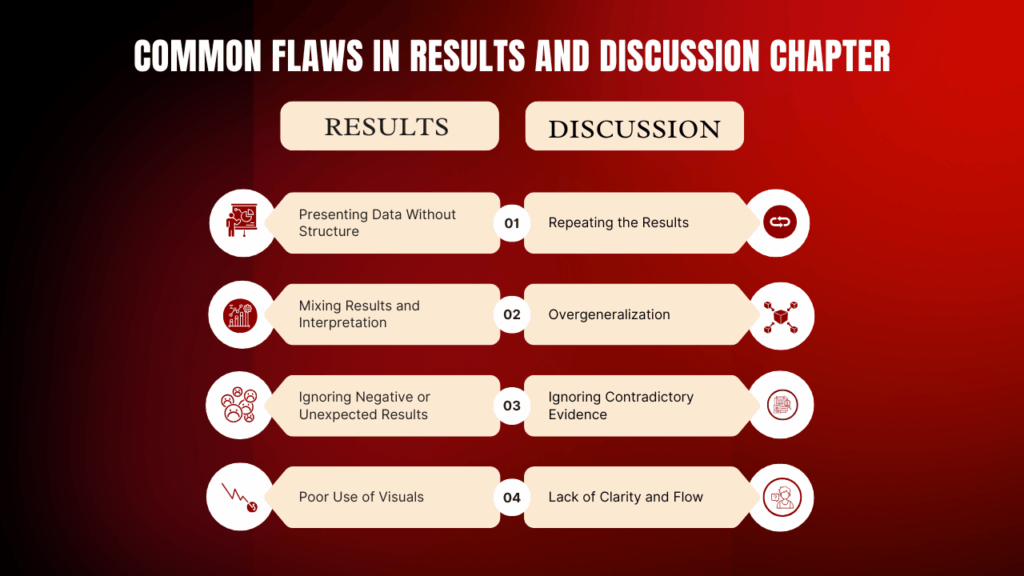How to Avoid Common Flaws in Results and Discussion Chapters?
Kenfra Research - Bavithra2025-11-10T17:22:12+05:30Writing a research paper or thesis can be challenging, especially when it comes to the Results and Discussion chapters. These sections are crucial because they showcase your findings and interpret their significance. However, many students and researchers struggle with common mistakes that can reduce the quality of their work. In this guide, we’ll explore practical tips on how to avoid common flaws in results and discussion chapters, ensuring your research stands out.
Purpose of Results and Discussion Chapters in Research
Before diving into common mistakes, it’s important to understand the purpose of each chapter:
- Results Chapter: This section presents your research findings clearly and objectively. It should include tables, figures, and summaries without personal interpretation. Think of it as showing your evidence.
- Discussion Chapter: This chapter interprets the results. Here, you explain what your findings mean, how they relate to previous research, and their implications.
Keeping the purpose of each chapter in mind is the first step to avoiding common errors.

Common Flaws in the Results Chapter
1. Presenting Data Without Structure
One of the most common mistakes is dumping raw data without proper organization. Readers should be able to understand your findings at a glance.
How to Fix:
- Use tables, charts, and graphs to summarize data.
- Arrange information logically—consider chronological order, themes, or research questions.
- Highlight key findings to make them easy to spot.
By focusing on how to present research results and maintaining a strong Results chapter structure, you can ensure your data is clear, professional, and easy to interpret.
2. Mixing Results and Interpretation
The Results chapter should focus on facts. Introducing interpretations or explanations here can confuse readers.
How to Fix:
- Stick to reporting what your data shows.
- Move any analysis, implications, or personal interpretations to the Discussion chapter.
Pro Tip: A simple way to remember: Results = Facts, Discussion = Interpretation.
3. Ignoring Negative or Unexpected Results
A common flaw in the Results chapter is avoiding or omitting results that don’t support the original hypothesis. Ignoring these findings can seriously undermine the credibility of your research.
How to Fix:
- Always report all findings, even if they are unexpected. Transparency builds trust and strengthens your study.
- In the Discussion chapter, explain why some results may not align with expectations. This is key for how to handle unexpected findings effectively.
By reporting negative results in research properly, you provide a complete and honest picture of your study, enhancing both reliability and impact.
4. Poor Use of Visuals
Charts, tables, and graphs are essential tools, but they can be misused. Overcrowded tables, unclear labels, or irrelevant figures weaken your results.
How to Fix:
- Keep visuals simple and relevant.
- Label all axes, include units, and provide clear captions.
- Refer to each figure or table in the text.
Common Flaws in the Discussion Chapter
1. Repeating the Results
Repeating every detail from the Results chapter is a common mistake. The Discussion should interpret, not summarize again.
How to Fix:
- Focus on explaining what the results mean.
- Compare your findings with existing studies.
- Highlight trends, patterns, and implications.
Following these Discussion chapter tips helps you maintain clarity while avoiding repetition in thesis writing.
2. Overgeneralization
Some researchers draw broad conclusions that their data doesn’t fully support. This can weaken your credibility.
How to Fix:
- Base conclusions strictly on your data.
- Acknowledge limitations of your study.
- Suggest areas for further research without overstating your claims.
3. Ignoring Contradictory Evidence
Ignoring studies that contradict your findings creates bias. Discussion should be balanced and objective.
How to Fix:
- Discuss why your results may differ from other studies.
- Explain possible reasons for discrepancies—sample size, methodology, or context.
4. Lack of Clarity and Flow
A Discussion chapter that is full of jargon or presents scattered points can easily confuse readers. Maintaining a logical flow is crucial for effectively communicating your research.
How to Fix:
- Start with a brief summary of key results to set the context.
- Organize your discussion around research questions or thematic areas, following a clear Discussion chapter structure.
- Conclude with implications, limitations, and recommendations to provide a strong finish.
By focusing on writing a clear discussion chapter and knowing how to write research discussion effectively, you ensure that your insights are easy to follow and impactful.

Essential Tips to Improve Your Results and Discussion Chapters
- Plan Before Writing: Outline each chapter with headings and subheadings. Decide where each result or interpretation belongs.
- Use Simple and Clear Language: Avoid unnecessary jargon or overly complex sentences. Your goal is clarity.
- Follow a Consistent Style: Keep tables, figures, and references consistent with your chosen citation style.
- Check for Data Accuracy: Always double-check numbers, calculations, and statistical results.
- Seek Feedback: Have peers or supervisors review your chapters before submission. Fresh eyes often catch errors you may overlook.
- Reference Correctly: Support your discussion with relevant studies and cite properly to enhance credibility.
Conclusion
Avoiding common flaws in the Results and Discussion chapters is essential for producing a high-quality thesis or research paper. Remember these key points:
- Keep the Results chapter factual and structured.
- Use visuals effectively and avoid clutter.
- Interpret findings in the Discussion chapter without repeating results.
- Acknowledge limitations and contradictory evidence.
- Write clearly and maintain logical flow.
By following these guidelines and leveraging Kenfra Research expertise, you can create chapters that are both clear and credible, increasing the impact of your research.








Leave a Reply